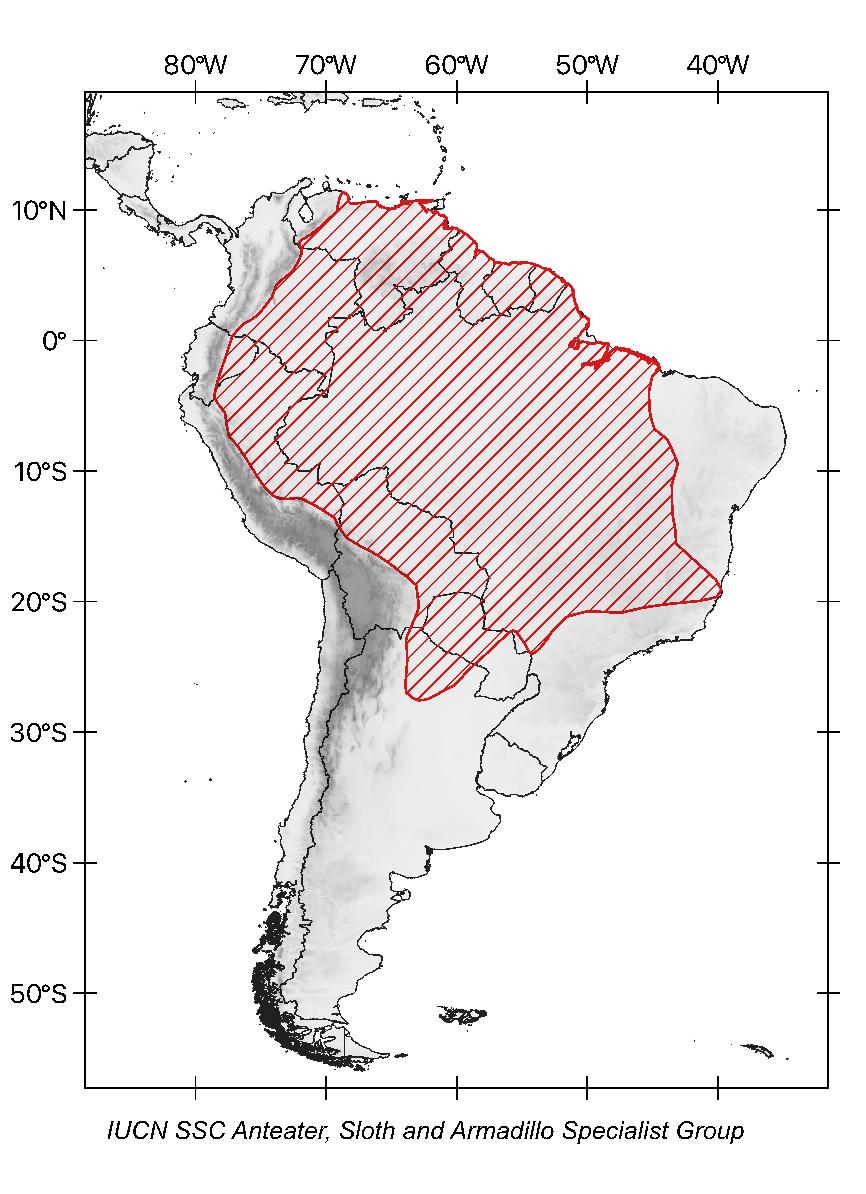Giant armadillo
(Priodontes maximus)
other common names
—
Taxonomy
Order: Cingulata
Family: Chlamyphoridae
Subfamily: Tolypeutinae


description
This is the largest of all extant armadillo species. It measures about 75 to 100 cm from the head to the base of the tail, which is about 40 to 50 cm long. Its weight varies between 20 and 60 kg, but animals of up to 80 kg have been recorded in captive conditions. The carapace is dark brown to black, with a broad light-colored band around its lower part and 11 to 13 movable bands. The claws on its forefeet are thick and powerful.

diet
Giant armadillos are mainly insectivorous, eating primarily ants and termites. They occasionally eat other invertebrates, such as spiders, beetles, cockroaches, millipedes, and worms, small snakes, carrion, and rarely figs and other fruit.

range
The giant armadillo occurs in northern and central South America, always east of the Andes, in Colombia, Venezuela, the Guianas, Brazil, Ecuador, Peru, Bolivia, Paraguay, and northern Argentina. It can be found at altitudes up to 500 m asl.

reproduction
Male and female giant armadillos reach sexual maturity at 6.5–8 years of age. Gestation length is 5 months, and the females usually give birth to one offspring. Parental care is long. The offspring remain inside the burrow and are completely dependent of the mother’s milk for 6–8 months. The females sometimes leave their offspring inside the burrow and close the entrance to impede predator attacks.
Although the weaning process ends at about 1 year of age, the offspring remain with their mother until they are 18 months old. Due to the long dependence of the offspring from their mother, the interbirth interval probably exceeds 3 years.

curious facts
The claw on the third forefinger can measure up to 20.3 cm along the curve, which makes it the largest claw of any living mammal. As a consequence, giant armadillos walk on the tip of their front claws. Giant armadillos have more teeth than any other armadillo species and most other mammals. The total number of teeth is highly variable and can reach 100 or even more.

threats
The main threat to the species is habitat loss and fragmentation due to deforestation, land use change and agriculture. Wildlife vehicle collisions and hunting for meat (generally for subsistence) are also affecting it. The illegal capture of giant armadillos for clandestine sale to wealthy animal collectors may be a threat, but is difficult to quantify.
Wildfires can have a severe impact on the species; Priodontes was found to be one of the species most affected by the mega fires in the Pantanal in 2020. Beekeepers retaliate against giant armadillos that destroy their hives in search of larvae. Although not quantified, it is highly probable that pesticides represent a threat to giant armadillo health, reproduction, and general fitness.

HaBITAT and ECOLOGy
This species lives in undisturbed primary rainforests, dry forests, humid to dry lowland forests, and savannas. It is highly fossorial and nocturnal, but may be active during the day especially inside burrows. Burrows are often constructed in sloped terrain near water bodies or under active termite mounds. At least 26 other vertebrate species have been observed using giant armadillo burrows. Giant armadillos are naturally rare where they occur. They have very large home ranges, of 450 to 1500 hectares. Depending on the area, they occur at densities between 4.7 and 6.3 individuals per 100 km².
Based on available scientific information, the generation length has been estimated at 11 years.

Population trend
Decreasing.

conservation status
Priodontes maximus has a wide area of distribution, but it is rare over its entire range and is very patchily distributed. The main threat to the species is habitat loss and fragmentation due to deforestation, land use change, and agriculture, but the species is also affected by hunting for meat and vehicle collisions. On the other hand, the recent increase in wildfires in several parts of its range has a severe impact on this species, including in pristine and/or protected areas such as Emas National Park, Amazonian forest, and the Pantanal.Furthermore, it is sometimes captured to be kept as a pet or to be illegally sold as a “living fossil”, but it usually does not survive long in captivity. These threats have led to an estimated population decline of at least 30% in the past three generations (which corresponds to around 33 years), and the species has disappeared from large parts of its southern range. Hence, it is listed as Vulnerable under criterion A2cd. The giant armadillo has disappeared from large parts of its southern range; in fact, it is categorized as potentially extinct in Uruguay, listed as Endangered in Argentina and Paraguay, and considered Vulnerable in eight countries.
Priodontes maximus is included in Appendix I of the Convention on International Trade in Endangered Species of Wild Fauna and Flora (CITES) and on the international list of endangered species under the United States Endangered Species Act.